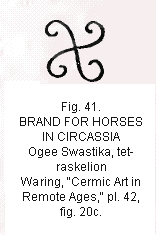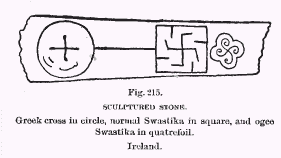

The Swastika
Definitions, Description & Origin
Cartailhac says: (1)
Modern Christian archaeologists have obstinately contended that the Swastika was composed of four gamma, and so have called it the Croix Gammé. But the Ramayana placed it on the boat of the Rama long before they had any knowledge of Greek. It is found on a number of Buddhist edifices; the Sectarians of Vishnu placed it as a sign upon their foreheads. Burnouf says it is the Aryan sign par excellence. It was surely a religious emblem in use in India fifteen centuries before the Christian era, and thence it spread to every part. In Europe it appeared about the middle of the civilization of the bronze age, and we find it, pure or transformed into a cross, on a mass of objects in metal or pottery during the first age or iron. Sometimes its lines were rounded and given a graceful curve instead of straight and square at this ends and angles. [See letter by Gandhi, pp. 803, 805.]
M. Cartailhac notes (2) several facts concerning the associations of the Swastika found by him in Spain and Portugal and belonging to the first (prehistoric) age of iron: [1] The Swastika was associated with the silhouettes of the duck , or bird, similar to those in Greece, noted by Goodyear; [2] the association (in fig. 41)
 on a slab from the lake dwellings, of the Maltese cross and reproduction
of the triskelion; [3] a tetraskelion, which he calls a Swastika "flamboyant,"
being the triskelion, but with four arms, the same shown on Lyeian coins
as being ancestors of the true triskelion (his fig. 412); [4] those objects
were principally found in the ancient lake dwellings of Sambroso and Briteiros,
supposedly dating from the eighth and ninth centuries B. C. With them
were found many ornaments, borders representing cords, spirals, meanders,
ect., which had the same appearance as those found by Schliemann at Mycenae.
Cartailhac says: (3)
on a slab from the lake dwellings, of the Maltese cross and reproduction
of the triskelion; [3] a tetraskelion, which he calls a Swastika "flamboyant,"
being the triskelion, but with four arms, the same shown on Lyeian coins
as being ancestors of the true triskelion (his fig. 412); [4] those objects
were principally found in the ancient lake dwellings of Sambroso and Briteiros,
supposedly dating from the eighth and ninth centuries B. C. With them
were found many ornaments, borders representing cords, spirals, meanders,
ect., which had the same appearance as those found by Schliemann at Mycenae.
Cartailhac says: (3)Without doubt Asiatic influences are evident in both cases; first appearing in the Troad, then in Greece, they were spread through Iberia and , possibly, who can tell, finally planted in a far-away Occident. A writer in the Edinburgh Review, in an extended discussion on "The pre-christian cross," treats of the Swastika under the local name of "Fylfot," but in such an enigmatical and uncertain manner that it is difficult to distinguish it from other and commoner forms of the cross. Mr. Warling (4) criticizes him somewhat severely for his errors:
He states that it is found * * * in the sculptured stones of Scotland (but after careful search we can find only one or two imperfect representations of it, putting aside the newton stone inscription, where it is probably a letter or numeral only); that it is carved on the temples and other edifices of Mexico and Central American (where again we have sought for it in vain); that it is found on the cinerary urns of the terramare of Parma and Vicenza, the date of which has been assigned by Italian antiquaries to 1000 B.C. (but there again we have found only the plain cross, and not the fylfot). and, finally, he asserts that "it was the emblem of Libitina or Persephone, the awful Queen of the Shades, and it therefore commonly found on the dress of the tumulorum fossor in the Roman catacombs," but we have only found one such example.
"It is noteworthy, too," he continues, "in reference to its extreme popularity, or the superstitious veneration in which it has been also universally held, that the cross pattée, or cruciform hammer (but we shall show these are different symbols), was among the very last of purely pagan symbols which was religiously preserved in Europe long after the establishment of Christianity (not in Europe, but in Scandinavia and wherever the Scandinavians had penetrated). * * * It may be seen upon the bells of many of our parish churches, as at Appleby, Mexborough, Haythersaye, Waddington, Bishop's Norton, West Barkwith, and other places, where it was placed as a magical sign to subdue the vicious spirit of the tempest;" and he subsequently points out its constant use in relation to water or rain.
Mr. Waring continues:
The Rev. C. Boutell, in "Notes and Queries, " points out that it is to be found on many medieval monuments and bells, and occurs -- e.g., at Appleby in Lincolnshire (peopled by Northmen) -- as an initial cross to the formula on the bell "Sta. Maria, o.p.n. and c." In these cases it has clearly been adopted as a Christian symbol. In the same author's "Heraldry," eh merely describes it as a mystic cross.
Mr. Waring makes one statement which, being within his jurisdiction, should be given full credit. He says, on page 15:
It [the Swastika] appears in Scotland and England only in those parts where Scandinavians penetrated and settled, but is not once found in any works of purely Irish or Franco-Celtic art.
He qualifies this, however, by a note:
I believe it occurs twice on an "Ogam" stone in the Museum of the Royal Irish
 Academy,
figured in Wilde's Catalogue (p. 136), but the fylfots are omitted in
the woodcut. [See fig. 215.]
Academy,
figured in Wilde's Catalogue (p. 136), but the fylfots are omitted in
the woodcut. [See fig. 215.]Dr. Brinton, (5) describing the normal Swastika, "with four arms of equal length, the hook usually pointing from left to right," says: "In this form it occurs in India and on very early (Neolithic) Grecian, Italic, and Iberian remains." Dr. Brinton is the only author who, writing at length or in a critical manner, attributes the Swastika to the Neolithic period in Europe, in this, more than likely, he is correct. Professor Virchow's opinion as to the antiquity of the hill of Hissarlik, wherein Dr. Schliemann found so many Swastikas, should be considered in this connection. (Seel p. 832, 833 of this paper.) Of course, its appearance among the aborigines of America, we can imagine, must have been the Neolithic period.
ENDNOTES:
1. "Ages Prehistorique de l'espagne et du Portugal," pp. 285-293. [Back]
2. Ibid., p. 286. [Back]
3. Ibid., p. 293. [Back]
4. "Ceramic Art in Remote Ages," p. 13. [Back]
5. Proe. Amer. Philosoph. Soc., 1889 xxix, p. 179. [Back]
<< Previous Page Next Page >>
© 2004-2007 Northvegr.
Most of the material on this site is in the public domain. However, many people have worked very hard to bring these texts to you so if you do use the work, we would appreciate it if you could give credit to both the Northvegr site and to the individuals who worked to bring you these texts. A small number of texts are copyrighted and cannot be used without the author's permission. Any text that is copyrighted will have a clear notation of such on the main index page for that text. Inquiries can be sent to info@northvegr.org. Northvegr™ and the Northvegr symbol are trademarks and service marks of the Northvegr Foundation.

|